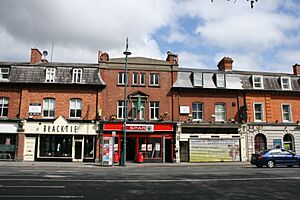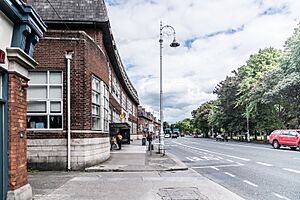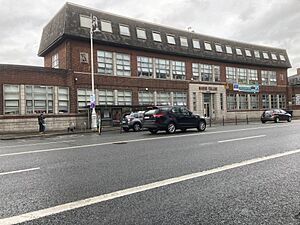Fairview, Dublin facts for kids
Quick facts for kids
Fairview
Fionnradh arc
|
|
|---|---|
|
Suburb
|
|
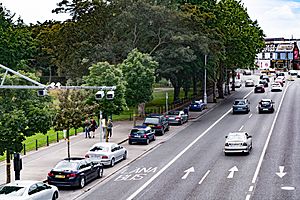
Fairview pictured from a pedestrian bridge, with Fairview Park to the left
|
|
| Country | Ireland |
| Province | Leinster |
| County | Dublin |
| Local authority | Dublin City Council |
| Elevation | 4 m (13 ft) |
| Time zone | UTC+0 (WET) |
| • Summer (DST) | UTC-1 (IST (WEST)) |
Fairview (which is Fionnradharc in Irish) is a suburb located near the coast in Dublin, Ireland. It is managed by Dublin City Council. A large part of the area is Fairview Park, a fun place to visit that was built on land taken from the sea.
Contents
Exploring Fairview: Location and Transport
Fairview is easy to reach from Dublin city. You can get there by a main road that goes through North Strand. This road then continues towards Malahide, Howth, and Clontarf.
How to Get Around Fairview
Fairview has good public transport.
- The DART train stops at Clontarf Road station, which is close by.
- Many Dublin Bus routes also serve the area. These include routes like 14, 15, 27/ABNX, 29A/N, 31/B, 32/ABX, 42/N, 43, 123, and 130.
Fairview's Neighbours
Fairview is surrounded by other interesting areas.
- To the north is Marino.
- To the west are North Strand and Ballybough.
- East Wall is to the southwest.
- Clontarf is to the east.
Fairview is also a parish in the Roman Catholic Archdiocese of Dublin. The main church here is the Church of Visitation of the Blessed Virgin Mary.
What's in a Name? The Story of Fairview
Before the late 1700s, this area was known as Ballybough. You can still see some street signs that show its old Irish name, Baile Bocht.
The name Fairview came about when the parish of Fairview was created in 1879. It was separated from Clontarf. The name likely came from a local church called Our Lady of Fair View, which was dedicated in 1819. Fairview and Marino were once part of a larger area called Clonturk, which also included Drumcondra.
Fairview's Past: A Look at History
In the 1300s, much of Fairview was farmland. This land was owned by St Mary's Abbey. Later, during a time when monasteries were closed down, the land was given to different families.
Early Communities in Fairview
Around 1718, one of Dublin's first Jewish communities settled in an area then called Annadale, which is part of Fairview today. These families came from Portugal and Spain. They were seeking safety and initially lived in Dublin city. Their village in Annadale was connected to Fairview by a lane that later became Philipsburgh Avenue. The community later moved to other parts of Dublin in the late 1800s and early 1900s.
Dublin's oldest Jewish Cemetery, Ballybough Cemetery, is located on Fairview Strand. It was built in 1718. The cemetery's chapel was added in 1857 and holds over 200 graves. The last burial there was in 1958.
Fairview's Growth and Development
The Richmond Road connects Fairview to Drumcondra. It was built to provide access to Drumcondra Castle. In the mid-1700s, a wealthy merchant named Francis Jacob Grose built a house called Richmond House. This house is now the site of St. Vincent's Hospital. Some people believe that Huguenots, who were refugees, also built houses along Richmond Road.
From the late 1700s, industries started in Fairview. Factories made flint glass, including glass for Dublin Castle. One factory even made a chandelier for the Irish Houses of Parliament with 1233 glass pieces! Because there were so many factories, a lane was called Factory Lane, which is now Esmonde Avenue.
Fairview began to grow much more after the Annesley Bridge was built in 1797. This bridge made it much easier to access the land. Before 1797, there was no way to cross the River Tolka below Ballybough Bridge.
Many houses were built in the 1800s. For example, Cadogan and Addison Roads were built and named after important Dublin families. Bushfield House, built around 1790, still stands on Philipsburgh Avenue. By 1855, when Fairview Church opened, there were many houses in the area. Horse trams and later railway trams also made it easier to travel to Fairview.
Things to Do and See in Fairview
The main shopping and activity areas are Fairview, a busy road next to Fairview Park, and Fairview Strand. Fairview Strand is a smaller area with shops and homes. It runs from Edge's Corner to Luke Kelly Bridge.
St Vincent's Hospital was started in 1857. It is on Richmond Road and provides mental health services for Dublin city.
Fairview's Parks and Green Spaces
| Fairview Park | |
|---|---|
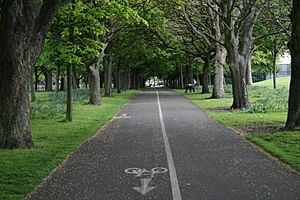
Fairview Park, Dublin
|
|
| Type | Urban park |
| Location | Fairview, Dublin |
| Area | 20 hectares (0.20 km2) |
| Created | 1934 |
| Operated by | Office of Public Works |
| Open | All year |
Fairview Park (Páirc Fionnradharc in Irish) is a large park with lots to do.
- It has playing fields for sports.
- There are playgrounds for children.
- You can enjoy walks along tree-lined paths.
The park was created in the late 1920s on land that was once a muddy area near the sea. The River Tolka flows past the park. The Clontarf Road DART station is very close. Across the railway line, there is an athletics track and a hall for Irish traditional music.
A statue of Seán Russell was put up in Fairview Park in 1951, and a new one was added in 2009. The park also has a sculpture called Family Unit 1 by Joe Moran.
Fairview Park was made smaller for a while in the 2000s when the Dublin Port Tunnel was being built. But the park has now been fully restored. It has two small playgrounds and a larger one that includes a skate park. The park also has several soccer pitches.
A smaller park, Bram Stoker Park, is located near the Georgian buildings of Marino Crescent. This park and street are actually in the neighbouring area of Clontarf. The famous writer Bram Stoker, who wrote Dracula, was born at number 15 Marino Crescent.
Public Services in Fairview
Fairview has important public services nearby.
- A Garda Síochána (police) station is in nearby Clontarf.
- A Dublin Fire Brigade and ambulance station is just across the Tolka River.
- There is a credit union on Fairview Strand.
- A Post Office is located on Marino Mart.
- Dublin City Libraries has a branch on the main road in Fairview.
Learning in Fairview: Education
Fairview has several schools.
- St. Joseph's Secondary C.B.S., Fairview is a secondary school. A famous past student is Charles Haughey, who was a Taoiseach (Prime Minister) of Ireland.
- Marino College is another secondary school in nearby Marino.
- St. Marys national school for girls is close to Richmond Road.
Fairview's Churches and Religious Sites
Fairview is a parish within the Roman Catholic Archdiocese of Dublin. The main church, the Church of Visitation of the Blessed Virgin Mary, started construction in 1853 and opened in 1855. Fairview Hall is a Gospel Hall on Annesley Bridge Road.
Famous People from Fairview
Many notable people have lived in or have connections to Fairview.
- Cathal Brugha, a revolutionary and politician, was born on Richmond Avenue.
- Éamonn Ceannt, one of the seven leaders who signed the Proclamation of the Irish Republic, lived on Fairview Avenue.
- Kathleen and Tom Clarke, also important figures in Irish history, lived on Richmond Avenue.
- James Joyce, a very famous writer, lived at several addresses in Fairview between 1896 and 1901.
- Thomas McDonagh, another signer of the Proclamation of the Irish Republic, lived at Woodlands on Philipsburgh Avenue.
- Maureen Potter, a well-known actress and performer, grew up on St. Joseph's Terrace.
- Larry Gogan, a popular broadcaster.
- Rosie Hackett, who was active in the trade union movement and the 1916 Rising, lived in Fairview.
Images for kids




